
Marine Heat Exchanger
5,000 - 10,000 Per Piece
1 Piece (MOQ)

Marine Plate Heat Exchanger
100,000 - 500,000 Per Unit
1 Unit (MOQ)
Best Deals from Marine Heat Exchanger

Drum Heat Exchanger
Get Price Quote
1 Piece (MOQ)
We are offering a drum heat exchanger is heat transfer equipment used for transferring heat between two fluids that are at different temperatures. The drum heat exchanger consists of a cylindrical drum that is divided into two sections by a partition wall. The heat is transferred from the hotter fluid to the cooler fluid through the walls of the tubes. Drum heat exchangers are commonly used in the chemical and petrochemical industries for heating or cooling process fluids.
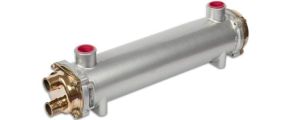
Marine Heat Exchanger
20,000 - 50,000 Per Piece
1 Piece (MOQ)

MARINE HEAT EXCHANGER/COOLER & SPARES
Get Price Quote
Leading Wholesale Trader of Alfa Laval Gasketed Plate Heat Exchangers, Alfa Laval MMPX-403 Complete Module, Alfa Laval EPC-400 Control Board, and Alfa Laval EPC/ Viscochief Controller from Bhavnagar.

marine heat exchangers
Get Price Quote
We are leading Manufacturer, Supplier and Exporter of Marine heat exchangers, chennai, India that is manufactured by using high grade raw material as per the client’s requirements. Our range is available in various sizes & specifications and is widely used in different rice mills. These are appreciated in the worldwide market and are offered at the competitive prices.

Marine Heat Exchanger
Get Price Quote

Marine Plate Heat Exchanger
Get Price Quote
Marine Plate Heat Exchanger that we supply is procured from the trusted manufacturers and venders of the market. Our Marine Plate Heat Exchanger is appreciated for its high strength, optimum corrosion resistance and accurate dimensions. We make available Marine Plate Heat Exchanger in different sizes and other technical specifications. Moreover, we gladly welcome the bulk orders for Marine Plate Heat Exchanger.

Marine Heat Exchanger
Get Price Quote
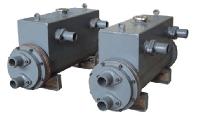
Marine Heat Exchanger
Get Price Quote
The Marine Heat Exchangers, which we offer, are available in the tubular form, or with an integral header tank, and models are available to suit engines of various outputs. This Marine Heat Exchanger is acclaimed for fast cooling of the marine engine. We are a dependable Manufacturer, Supplier and Exporter of Marine Heat Exchanger. Construction This Marine Heat Exchanger has a bundle of tubes, where two cooling circuits meet and exchange the heat. This bundle of tubes could be in the cooling circuit of an engine (Marine Heat Exchanger), the oil circuit (oil cooler) or intake air (inter cooler). There is a boat that we can supply with a heat exchanger to suit from the smallest petrol or diesel engine to large V8 petrol and medium-range diesels; Vertical Mounting with Integral Header Tank Horizontal mounting with Integral Header. We can manufacture the Tank of Marine Heat Exchanger, using modular construction from standard components. Design : As per ASME Section VIII Div. 1, TEMA RCB, IS 2825 & IS 4503. Capacity : As per Customer Requirements/standard Design Material of Construction : Size ranging from 3� to 100� in diameter & 40� (Feet) in length.

Marine Heat Exchanger
Get Price Quote
The company is a renowned Exporter and Supplier of Marine Heat Exchanger, which efficiently treats distilled water and antifreeze. The Marine Heat Exchanger transfers the heat from water-antifreeze combine to the incoming water from the water body. The efficiency of the Marine Heat Exchanger, as well as its long service life, ensures that the equipment is worth investing in.
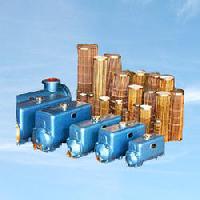
Marine Coolers Heat Exchanger
Get Price Quote
We are offering marine coolers heat exchanger.the offered marine coolers heat exchanger are the most common way to cool a boat's engine, using the lake, river or ocean water in which the boat floats. Since this water may be corrosive, the engine may be cooled by a sealed mixture of distilled water and antifreeze. Heat from the water�antifreeze mixture is then transferred to the ocean (or lake or river) water which flows into a heat exchanger. To protect the marine heat exchanger from corrosive salts, a sacrificial zinc anode is screwed into the heat exchanger. This anode must be periodically replaced as part of regular maintenance. Because the water the boat floats in may be contaminated with floating particles such as wood or other detritus most boats will have a filter (often stainless steel mesh) to remove these particles before they flow through the heat exchanger. This filter must be periodically cleaned or else the flow of water to the heat exchanger will become obstructed and the engine will overheat. There are three methods employed for water-cooled marine petrol and diesel engines they are: direct cooling: direct cooling of the cylinders and heads by sea-water is unsatisfactory, because the engine - which was probably originally designed for radiator cooling - will run too cold and the sea-water will eventually run the cylinder block and headsheat exchanger cooling: heat exchanger cooling is the most common method, the seawater being isolated in components which can be designed to withstand its corrosive effect. The closed fresh-water circuit can be thermostatically controlled so that the engine operates at its design temperaturekeel cooling: keel cooling is suitable for small boats operating in shallow weedy water, but the need for pipe work external to the hull is a severe limitation

Marine Heat Exchanger
Get Price Quote
The company is a renowned Exporter and Supplier of <strong>Marine Heat Exchanger,</strong> which efficiently treats distilled water and antifreeze. The Marine Heat Exchanger transfers the heat from water-antifreeze combine to the incoming water from the water body. The efficiency of the Marine Heat Exchanger, as well as its long service life, ensures that the equipment is worth investing in.

Marine Tube Heat Exchanger
65,000 Per Piece

Marine Heat Exchanger
Get Price Quote
These types of Heat exchangers are having two divisions one is shell and other is Tubes. Here One fluid runs through the tubes, and another fluid flows over the tubes (through the shell) to transfer heat between the two fluids. For this purpose seamlessERW or Rolled pipes are used for shell. And Seamless tubes are used for Tubes. Our Shell and Tube Heat Exchangers Design Process Contains Two Parts - Thermal and Mechanical Design.

Marine Heat Exchanger
Get Price Quote
Marine heat exchangers are the most common way to cool a boat's engine, using the lake, river or ocean water in which the boat floats. Since this water may be corrosive, the engine may be cooled by a sealed mixture of distilled water and antifreeze. Heat from the water–antifreeze mixture is then transferred to the ocean (or lake or river) water which flows into a heat exchanger. To protect the marine heat exchanger from corrosive salts, a sacrificial zinc anode is screwed into the heat exchanger. This anode must be periodically replaced as part of regular maintenance. Because the water the boat floats in may be contaminated with floating particles such as wood or other detritus most boats will have a filter (often stainless steel mesh) to remove these particles before they flow through the heat exchanger. This filter must be periodically cleaned or else the flow of water to the heat exchanger will become obstructed and the engine will overheat.
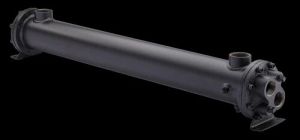
Marine Heat Exchanger
80,000 Per Piece
1 Piece (MOQ)

Marine Heat Exchanger
Get Price Quote
Large ships frequently hold evaporating plants to fabricate fresh water, thus tumbling their reliance on shore-based supplies. Steam ships must be able to manufacture high-quality distillate in organize to maintain boiler-water levels. Diesel-engine ships frequently utilize waste heat as an energy foundation for producing fresh water. In this system, the engine-cooling water is passed through a heat exchanger, where it is cooled by concentrated seawater (brine). Because the cooling water (which is chemically treated fresh water) is at a temperature of 70-80 °C (158-176 °F), it would not be possible to flash off any water vapor unless the pressure in the heat exchanger vessel was dropped. To alleviate this problem, a brine-air ejector venturi pump is used to create a vacuum inside the vessel. Partial evaporation is achieved, and the vapor passes through a demister before accomplishment the condenser section. Seawater is pumped through the condenser section to cool the vapor sufficiently to precipitate it.The distillate gathers in a tray, from where it is pumped to the storage tanks. A salinometer monitors salt content and diverts the flow of distillate from the storage tanks if the salt content exceeds the alarm limit. Sterilization is carried out after the evaporator.
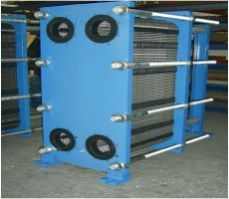
Marine Plate Heat Exchanger
Get Price Quote
We have well-connected and capacious warehouse that helps us in arranging products systematically to deal with urgent deliveries and orders. Our exceptionally good warehouse system helps us in keeping the products safe till the final dispatch. With our brilliant logistics network, we are capable to deliver the orders within the postulated time frame. The offered Marine Plate Heat Exchanger is available in different thicknesses varying from 0.3-6.0mm and more.

marine heat exchangers
Get Price Quote
We offered with a wide range of marine heat exchangers. Our range of marine heat exchangers is made out of the highest quality of raw materials that are procured out of our reliable vendors. They provide our clients with the best service possible. These are long lasting and durable.